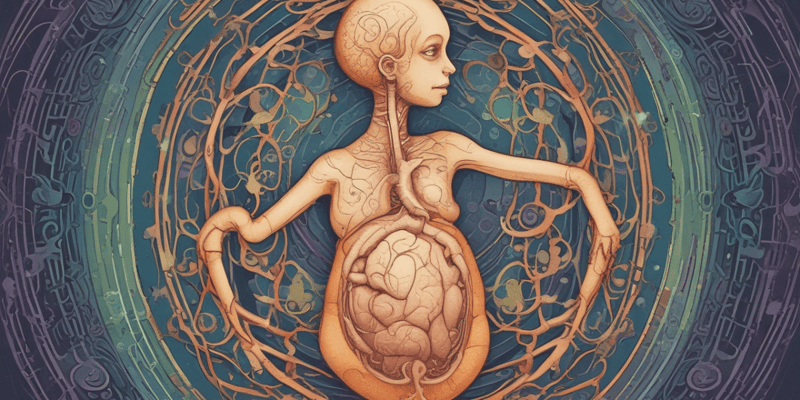10 Questions
What is the main purpose of the first stage of labor?
To soften and dilate the cervix
Which process characterizes the retraction phase of labor?
Shortening and thickening of the uterine upper segment
What biochemical changes initiate labor?
Prevention of Ca2+ influx
Which condition is associated with Bandl's ring?
Obstructed labor
What characterizes the resting tone of the uterus during pregnancy?
Never relaxes completely
Which process occurs during myometrial retraction?
Thickening of the uterine lower segment
What causes the formation of a constriction ring during labor?
Localised constriction of myometrium internally
In pregnancy, uterine contractions are characterized by:
Individual contraction of myometrial cells
'Electrical synchrony & Effective coordination' refers to:
Coordination among adjacent myometrial cells linked by gap junctions
Which term describes continuous shortening and thickening of the uterine upper segment?
Retraction ring formation
Study Notes
Fetal Lie and Presentation
- The fetal lie refers to the long axis of the fetus in relation to the mother.
- Fetal presentation is the part of the fetus that enters the maternal pelvis first and occupies the lower segment.
Types of Fetal Presentation
- Breech presentation: complete, footling, or shoulder/hand.
- Cephalic presentation: vertex, face, or brow.
Presenting Diameters
- Average term infant: cephalic presentation (e.g., vertex, face, or brow).
Fetal Position and Attitude
- Fetal position: the relationship of the denominator to the four quadrants of the pelvis.
- Fetal attitude: the descent of the fetal head.
Mechanism of Labour
- The process of labour involves engagement, descent, flexion, internal rotation, extension, and external rotation.
- Occipito-anterior is the most common mechanism of labour.
Cervical Softening and Dilatation
- Cervical softening: disarray of collagen fibres, increased hydrophilic GAGs, and proteolytic enzyme digestion of collagen.
- Cervical dilatation: the gradual opening of the cervix.
Symptoms of Labour Onset
- "Show" (mucous plug and small amount of blood).
- Contractions: increase in intensity and frequency.
- Spontaneous rupture of membranes.
Labour Stages
- First stage: from onset of regular uterine contractions to full cervical dilatation.
- Second stage: from full cervical dilatation to delivery of the baby.
- Third stage: from delivery of the baby to delivery of the placenta.
First Stage of Labour
- Latent phase: from onset of labour to 3/4/5 cm dilatation (depending on the partogram used).
- Active phase: from 3/4/5 cm dilatation to full dilatation.
- Monitoring: maternal condition, fetal condition, and progress of labour.
Monitoring Labour
- Maternal condition: initial full assessment, including history, observations, abdominal exam, and vaginal exam.
- Fetal condition: lie, presenting part, position, and fetal heart rate.
- Progress of labour: use of the partogram, fetal descent, dilatation, and effacement.
False Labour vs True Labour
- False labour: irregular intervals, long intervals, unchanged intensity, and uneffaced cervix.
- True labour: regular intervals, shortening intervals, increasing intensity, and progressive effacement and dilatation.
Partogram
- A graphic representation of labour, reflecting maternal condition, fetal condition, and progress of labour.
- Medico-legal implications: every patient, every labour, every time.
Biochemistry of Labour
- Prevention of Ca2+ influx: oxytocin, prostaglandin, and progesterone.
- Stimulation of Ca2+ influx: uterine contractions in pregnancy.
- Biochemical start of labour: prevention of Ca2+ influx, stimulation of Ca2+ influx, and electrical synchrony.
Uterine Contractions
- Individual contraction of myometrial cells.
- Braxton Hicks contractions.
- Contractions in labour: stimulation of Ca2+ influx, contraction, and retraction.
- Postpartum uterine contraction: contraction and retraction.
Test your knowledge on the fetal lie, presentation, attitude, and position in relation to the mother during childbirth. Learn about the different types of fetal presentations and positions for a smooth delivery process.
Make Your Own Quizzes and Flashcards
Convert your notes into interactive study material.
Get started for free




